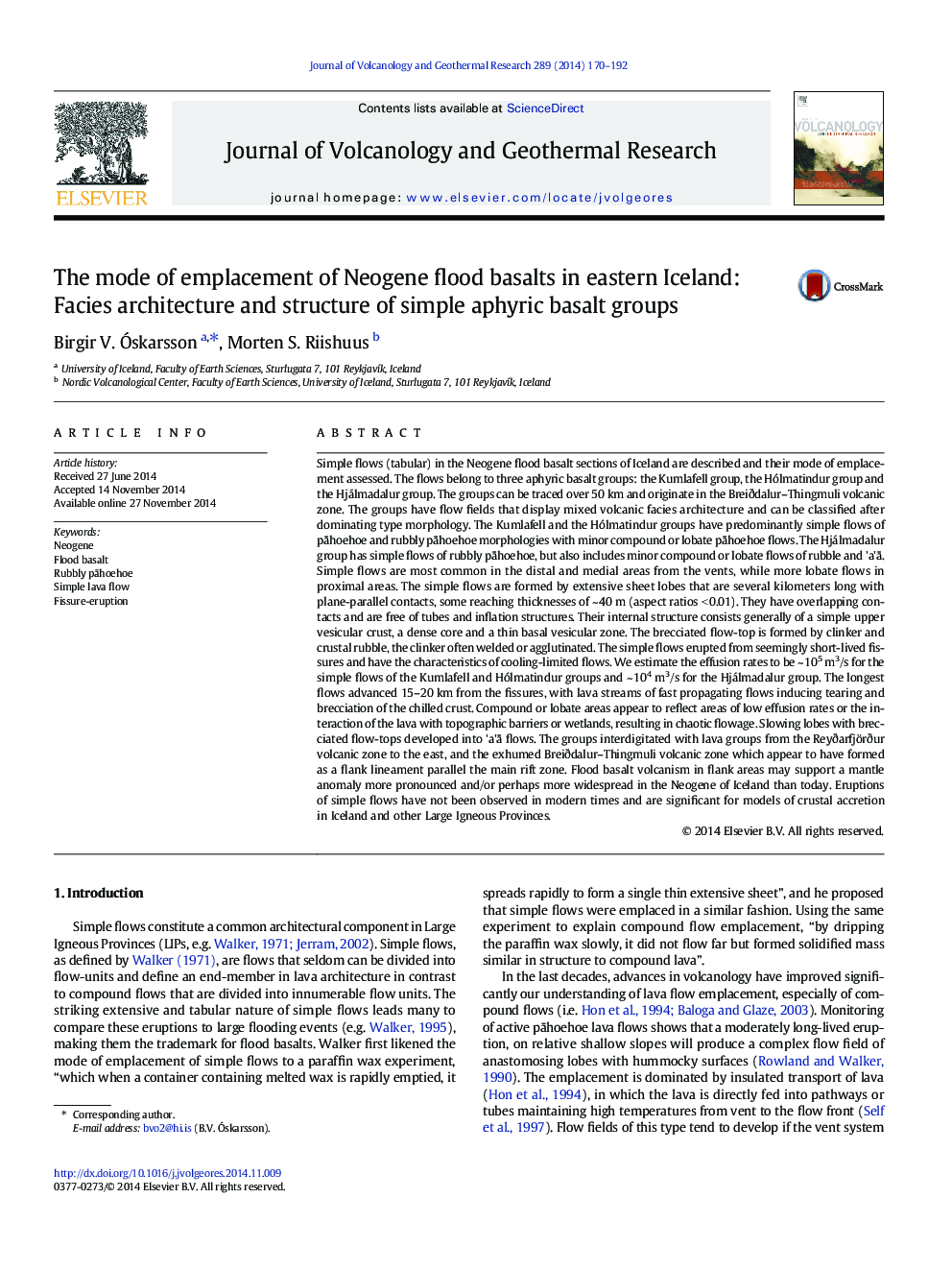| کد مقاله | کد نشریه | سال انتشار | مقاله انگلیسی | نسخه تمام متن |
|---|---|---|---|---|
| 6440044 | 1638333 | 2014 | 23 صفحه PDF | دانلود رایگان |
عنوان انگلیسی مقاله ISI
The mode of emplacement of Neogene flood basalts in eastern Iceland: Facies architecture and structure of simple aphyric basalt groups
ترجمه فارسی عنوان
حالت جایگزینی بازالت های سیلاب نئوژن در شرق ایسلند: معماری و ساختار فاکتورهای گروه های ساده بازالت
دانلود مقاله + سفارش ترجمه
دانلود مقاله ISI انگلیسی
رایگان برای ایرانیان
کلمات کلیدی
نئوژن، سد بازالت، روبلی پهههههو، جریان گدازه ساده، فیشر فوران،
موضوعات مرتبط
مهندسی و علوم پایه
علوم زمین و سیارات
ژئوشیمی و پترولوژی
چکیده انگلیسی
Simple flows (tabular) in the Neogene flood basalt sections of Iceland are described and their mode of emplacement assessed. The flows belong to three aphyric basalt groups: the Kumlafell group, the Hólmatindur group and the Hjálmadalur group. The groups can be traced over 50 km and originate in the Breiðdalur-Thingmuli volcanic zone. The groups have flow fields that display mixed volcanic facies architecture and can be classified after dominating type morphology. The Kumlafell and the Hólmatindur groups have predominantly simple flows of pÄhoehoe and rubbly pÄhoehoe morphologies with minor compound or lobate pÄhoehoe flows. The Hjálmadalur group has simple flows of rubbly pÄhoehoe, but also includes minor compound or lobate flows of rubble and 'a'Ä. Simple flows are most common in the distal and medial areas from the vents, while more lobate flows in proximal areas. The simple flows are formed by extensive sheet lobes that are several kilometers long with plane-parallel contacts, some reaching thicknesses of ~ 40 m (aspect ratios < 0.01). They have overlapping contacts and are free of tubes and inflation structures. Their internal structure consists generally of a simple upper vesicular crust, a dense core and a thin basal vesicular zone. The brecciated flow-top is formed by clinker and crustal rubble, the clinker often welded or agglutinated. The simple flows erupted from seemingly short-lived fissures and have the characteristics of cooling-limited flows. We estimate the effusion rates to be ~ 105 m3/s for the simple flows of the Kumlafell and Hólmatindur groups and ~ 104 m3/s for the Hjálmadalur group. The longest flows advanced 15-20 km from the fissures, with lava streams of fast propagating flows inducing tearing and brecciation of the chilled crust. Compound or lobate areas appear to reflect areas of low effusion rates or the interaction of the lava with topographic barriers or wetlands, resulting in chaotic flowage. Slowing lobes with brecciated flow-tops developed into 'a'Ä flows. The groups interdigitated with lava groups from the Reyðarfjörður volcanic zone to the east, and the exhumed Breiðdalur-Thingmuli volcanic zone which appear to have formed as a flank lineament parallel the main rift zone. Flood basalt volcanism in flank areas may support a mantle anomaly more pronounced and/or perhaps more widespread in the Neogene of Iceland than today. Eruptions of simple flows have not been observed in modern times and are significant for models of crustal accretion in Iceland and other Large Igneous Provinces.
ناشر
Database: Elsevier - ScienceDirect (ساینس دایرکت)
Journal: Journal of Volcanology and Geothermal Research - Volume 289, 1 December 2014, Pages 170-192
Journal: Journal of Volcanology and Geothermal Research - Volume 289, 1 December 2014, Pages 170-192
نویسندگان
Birgir V. Ãskarsson, Morten S. Riishuus,
